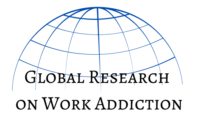Definition and symptoms
Currently, researchers are working on developing a widely recognized definition of work addiction as a behavioral addiction. Such definition describing crucial symptoms of work addiction may be useful in developing official criteria for diagnosing this problematic behavior.
So far, several diagnostic symptoms of work addiction defined within clinical framework were investigated scientifically. The results of the studies support the notion that these are valid criteria for recognizing work addiction:
- You think constantly about your work or you plan your work all the time or you think of how you can free up more time to work.
- You spend much more time working than initially intended or you feel compelled to do more and more, and work more and more.
- You work in order to reduce feelings of guilt, anxiety, helplessness and depression, or you work to forget about your personal problems.
- You have been told by others to cut down on work without listening to them or you unsuccesfully tried to reduce the amount of time spent on working.
- You become stressed if you are prohibited from working.
- You prioritise work over hobbies, leisure activities, and exercise.
You work so much it has negatively influenced your health or your sleep.
Importantly, these should not be treated in isolation, meaning that single symptom does not mean that you are addicted. However, if you recognize that few or all of the symptoms occur, it may mean that you are at risk of work addiction or you are addictied to work.
DEFINITION
A preliminary definition of work addiction as a behavioral addiction was suggested. This definition takes into account common elements of definitions of addictions and is congruent with most of the suggested and widely recognized definitions of a behavioral addiction to date (Grant, Potenza, Weinstein, & Gorelick, 2010; Griffiths, 1996, 2005; Holden, 2001; Karderfelt-Winther et al., 2017). These common elements are:
- engagement in the behavior to achieve appetitive effects (e.g., pain reduction, affect enhancement, arousal manipulation, and/or fantasy),
- total preoccupation with the behavior,
- loss of control, and
- suffering negative consequences.
These elements are also to a large extent congruent with most of the existing definitions of work addiction, which include the elements of preoccupation with work/compulsion or addiction to work, and negative consequences of excessive work (Andreassen & Pallesen, 2016; Fassel, 1992; Griffiths, 2011; Oates, 1971; Robinson, 2014, Schaufeli, Taris, & Bakker, 2006; Spence & Robbins, 1992; Taris, Schaufeli, & Verhoeven, 2005; for a overview, see Andreassen, 2014; Griffiths & Karanika-Murray, 2012; Sussman, 2012).
Therefore, work addiction is defined in the following way:
Part A (general definition)
Work addiction is characterized by:
- a compulsion to work and preoccupation with work activities
- leading to a significant harm and distress of a functionally impairing nature to the individual and/or other significantly relevant relationships (friends and family).
The behavior is characterized by:
- the loss of control over the working activity and
- persists over a significant period of time.
This problematic work-related behavior can have varying intensity from mild to severe.
Part B (complementary specific symptoms)
Loss of control over the working activity involves:
- working more than planned, despite the negative consequence and/or
- unsuccessful attempts to reduce the activity and/or
- progressive increase in time spent on working.
Withdrawal symptoms (including irritability, negative feelings, sleep problems, etc.) are:
- frequent if the planned/desired amount of work is hindered or
- appear when attempts at reduction of the amount of work are undertaken.
The work activity often serves to reduce negative feelings and/or avoid interpersonal and/or intrapersonal conflicts.
DIAGNOSTIC CONSIDERATIONS
In order to address the issue of different levels of problematic behavior, subclasses of mild, moderate, and severe work addiction could be used analogically to the currently used diagnostic criteria of alcohol-use disorder (American Psychiatric Association [APA], 2013). Advantages and disadvantages of this approach should be taken into account (Babor & Caetano, 2008; Hasin, 2012; O’Brien, 2011; Wakefield, 2015).
When it comes to loss of control, which is fundamental to all addictions, special care needs to be taken in order to distinguish between the need for control executed in relation to performing work itself, which is characteristic of many work addicts, and the loss of control over the degree of involvement in work and significantly reduced ability to control other aspects of their day-to-day lives (see Griffiths, 2013). In some sense, it is a dysfunctional tradeoff between increasing control over work and losing it over every other aspect of life. It is to some extent similar to one observed, for example, in anorexia nervosa in which case a person puts a lot of effort to control food intake, and at the same time suffers significant health conseqences, and may experience problems in many other spheres of life.
This loss of control over working activity could be reflected in unsuccessful attempts at reducing the behavior. However, it needs to be taken into account that addiction is strongly linked to denial and most of those who need help never recognize this fact or do not try to reduce the behavior (Goldstein et al., 2009).
